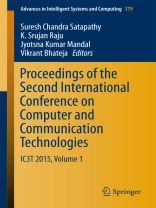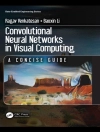The book is about all aspects of computing, communication, general sciences and educational research covered at the Second International Conference on Computer & Communication Technologies held during 24-26 July 2015 at Hyderabad. It hosted by CMR Technical Campus in association with Division – V (Education & Research) CSI, India. After a rigorous review only quality papers are selected and included in this book. The entire book is divided into three volumes. Three volumes cover a variety of topics which include medical imaging, networks, data mining, intelligent computing, software design, image processing, mobile computing, digital signals and speech processing, video surveillance and processing, web mining, wireless sensor networks, circuit analysis, fuzzy systems, antenna and communication systems, biomedical signal processing and applications, cloud computing, embedded systems applications and cyber security and digital forensic. The readers of these volumes will be highly benefited from the technical contents of the topics.
Содержание
Chapter 1. Medical Image Fusion in Curvelet Domain Employing PCA and Maximum Selection Rule.- Chapter 2. Gigabit Network Intrusion Detection System Using Extended Bloom Filter in Reconfigurable Hardware.- Chapter 3. Hash Based Rule Mining Algorithm in Data-Intensive Homogeneous Cloud Environment.- Chapter 4. Privacy Preservation in Distributed Environment Using RSA-CRT.- Chapter 5. Priority Based Classification: An Automated Traffic Approach.- Chapter 6. A Taxonomy of Software’s Non-Functional Requirements.- Chapter 7. Segmentation of the Human Corpus Callosum Variability from T1 Weighted MRI of Brain.- Chapter 8. Analysis of Organic Molecular Single Electron Transistor Using C4H6B2 with different Metal Electrodes.- Chapter 9. Analysis of Molecular Single Electron Transistors Using Silicene, Graphene And Germanene.- Chapter 10. Identification of the Plants Based on Leaf Shape Descriptors.- Chapter 11. Use of Global Positioning System to Track Movement of Mobile Node in Proxy Mobile Internet Protocol version 6.- Chapter 12. Is Mobile Cloud Computing Efficient for E-Learning?.- Chapter 13. A Comparative analysis of different Social Network Parameters Derived from Facebook Profiles.- Chapter 14. A Fast and Hardware Efficient Visual Cryptography Scheme for Images.- Chapter 15. Energy Efficient Modified Bellman Ford Algorithm for Grid and Random Network Topologies.- Chapter 16. Text Dependent vs. Text Independent Speech Emotion Recognition.- Chapter 17. A Novel Approach for Speaker Recognition by Using Wavelet Analysis and Support Vector Machines.- Chapter 18. Real Time Surveillance for Critical Activity Detection in ICU’s.- Chapter 19. High Speed Network Intrusion Detection System Using FPGA.- Chapter 20. Hawk Eye: A Plagiarism Detection System.- Chapter 21. A Novel Action Descriptor to Recognize Actions from
Surveillance Videos.-Chapter 22. Protecting the Augmented Browser Extension from Mutation Cross-site Scripting.-
Chapter 23. Large Scale Data Management System Using Data De-duplication System.-
Chapter 24. Movement detection Using Lab VIEW by Analysis of Real Time Video.-
Chapter 25. Connectivity Model for Molecular Communication Based Nano Machines Network in Normal and Sub-diffusive Regimes.-
Chapter 26. Application of Locally Weighted Regression for Predicting Faults Using Software Entropy Metrics.-
Chapter 27. Effect of Defects on Current-Voltage Characteristics of a Silicene ZNR Based Field Effect Transistor.-
Chapter 28. Performance Improvement of Read Operations in Distributed File System through Anticipated Parallel Processing.-
Chapter 29. Steerable Texture Descriptor for an Effective Content Based Medical Image Retrieval System Using PCA.-
Chapter 30. A Novel Multi-View Similarity for Clustering Spatio-Temporal Data.-
Chapter 31. WRSP-Miner Algorithm for Mining Weighted Sequential Patterns from Spatio-Temporal Databases.-
Chapter 32. Performance Analysis in Free Space Optical Communication System Using Aperture Averaging.-
Chapter 33. Performance Evaluation of Free Space Optical Link Under Various Weather Conditions.-
Chapter 34. Evolutionary Improved Swarm Based Hybrid K-means Algorithm for Cluster Analysis.-
Chapter 35. Analysis of Energy Efficient, LEACH Based Cooperative Wireless Sensor Network.-
Chapter 36. A Monotonic Digitally Controlled Delay Element Based Programmable Trigger Pulse Generator.-
Chapter 37. Layered-Encoding Video Multicasting IPTV over Mobile Wi MAX Networks.-
Chapter 38. Intuitionistic Fuzzy Similarity and Information Measures with Physical Education Teaching Quality Assessment.-
Chapter 39. Molecular Level Insight into the Interactions of Sox C and Sox D from Epsilonproteobacteria Sulfurimonas Denitrificans:A Bio-Molecular Computational Approach.-
Chapter 40. “Jugaad” – the Creativeness for Selection of Software Development Methodology Advisory System – Fuzzy Expert System.-
Chapter 41. A Framework for Data Clustering of Large Datasets in a Distributed Environment.-
Chapter 42. Segmentation of Ancient and Historical Gilgit Manuscripts.-
Chapter 43. Semantic-Based Approach for Automatic Annotation and Classification of Medical Services in Healthcare Ecosystem.-
Chapter 44. Real Time Graphs For Communication Networks: A Fuzzy Mathematical Model.-
Chapter 45. PWLCM Based Random Search for Strong Substitution Box Design.-
Chapter 46. Fuzzy C-means and Fuzzy TLBO for Fuzzy Clustering.-
Chapter 47. A Mean Based Thresholding Approach for Broken Character Segmentation from Printed Gujarati Documents.-
Chapter 48. Entity Resolution Based Jaccard Similarity Coefficient for Heterogeneous Distributed Databases.-
Chapter 49. Energy Efficient Algorithms for Hot Spot Problem in Wireless Sensor Networks.-
Chapter 50. Mining Community Based Top-k Experts and Learners in Online Question Answering Systems.-
Chapter 51. An Approach for Creating framework for Automated Question Generation from Instructional Objective.-
Chapter 52. Adaptive Output Feedback Control System Design for Low Cost Electronic Knee Prosthesis.-
Chapter 53. Low Leakage Low Power High Stable SRAM Cell Design.-
Chapter 54. Optimizing Routes in Mobile Ad hoc Networks Using Genetic Algorithm and Ant Colony Optimization.-
Chapter 55. Concatenation Technique for Extracted Arabic Characters for Efficient Content Based Indexing and Searching.-
Chapter 56. Harmonic elimination Using DSTATCOM.-
Chapter 57. Fault Tolerance in Wireless Sensor Networks: Finding Primary Path.-
Chapter 58. PSO Based Multiple-Sink Placement Algorithm for Pro-tracting the Lifetime of Wireless Sensor Networks.-
Chapter 59. De-noising of GPS Positioning Data Using Wavelet Based Hidden Markov Tree.-
Chapter 60. Parent Selection Based on Link Quality Estimation in WSN.-
Chapter 61. Enhanced Higher Order Orthogonal Iteration Algorithm for Student Performance Prediction.-
Chapter 62. A One to One Communication Model to Facilitate Conversation between Differently-abled People by a Portable and Handy Machine.-
Chapter 63. Malicious File Hash Detection and Drive-by Download Attacks.-
Chapter 64. Parameter Optimization of Support Vector Machine by Improved Ant Colony Optimization.-
Chapter 65. KT3F: A Key Based Two Tier Trust Management Filtering Scheme for Intrusion Detection in Wireless Sensor Network.-
Chapter 66. Cascading De-noising Algorithm for Improving GPS Positional Accuracy.-
Chapter 67. A Corpus of Word-level Offline Handwritten Numeral Images from Official Indic Scripts.-
Chapter 68. A Planar Ultra-Wide Band Antenna Design Using Circularly Truncated Corners and Notches.-
Chapter 69. Genetic Algorithm for k-connected Relay Node Placement in Wireless Sensor Networks.-
Chapter 70. Segmentation of Cotton Bolls by Efficient Feature Selection Using Conventional Fuzzy C Means Algorithm with Perception of Color.-
Chapter 71. System Dynamics Modeling for Analyzing Recovery Rate of Diabetic Patients by Mapping Sugar Content in Ice Cream and Sugar Intake for the Day.-
Chapter 72. Enhanced Stable Period for Two Level and Multilevel Heterogeneous Model for Distant Base Station in Wireless Sensor Network.-
Chapter 73. Dynamic Timetable Generation Using Constraint Satisfaction Algorithm.-
Chapter 74. Application of Genetic Algorithm for Evolution of Quantum Fourier Transform Circuits.-
Chapter 75. An Improved Polygon Clipping Algorithm Based on Affine Transformation.-
Chapter 76. Alternative Design Space Analysis for Electronic Commerce System.
Об авторе
Dr. Suresh Chandra Satapathy is currently working as Professor and Head, Department of Computer Science and Engineering, Anil Neerukonda Institute of Technology and Sciences (ANITS), Vishakhapatnam, Andhra Pradesh, India. He obtained his Ph D in Computer Science Engineering from JNTUH, Hyderabad and Master degree in Computer Science and Engineering from National Institute of Technology (NIT), Rourkela, Odisha. He has more than 27 years of teaching and research experience. His research interest includes machine learning, data mining, swarm intelligence studies and their applications to engineering. He has more than 98 publications to his credit in various reputed international journals and conference proceedings. He has edited many volumes from Springer AISC and LNCS in past and he is also the editorial board member in few international journals. He is a senior member of IEEE and Life Member of Computer society of India. Currently, he is the National Chairman of Division-V (Education and Research) of Computer Society of India.
Dr. K. Srujan Raju is the Professor and Head, Department of CSE, CMR Technical Campus. Professor Srujan earned his Ph D in the field of Network Security and his current research includes computer networks, information security, data mining, image processing, intrusion detection and cognitive radio networks. He has published several papers in referred international conferences and peer reviewed journals and also he was in editorial board of CSI 2014 Springer AISC series 337 and 338 volumes. In addition to this, he has served as reviewer for many indexed journals. Professor Raju is also awarded with Significant Contributor, Active Member Awards by Computer Society of India (CSI) and currently he is the Hon. Secretary of CSI Hyderabad Chapter.
Dr. J.K. Mandal has M.Sc. in Physics from Jadavpur University in 1986, M.Tech. in Computer Science from University of Calcutta. He was awarded Ph D. in Computer Science & Engineering by Jadavpur University in 2000. Presently, he is working as Professor of Computer Science & Engineering and former Dean, Faculty of Engineering, Technology and Management, Kalyani University, Kalyani, Nadia, West Bengal for two consecutive terms. He started his career as lecturer at NERIST, Arunachal Pradesh in September, 1988. He has teaching and research experience of 28 years. His areas of research include coding theory, data and network security, remote sensing and GIS based applications, data compression, error correction, visual cryptography, steganography, security in MANET, wireless networks and unify computing. He has produced 11 Ph D degrees, three submitted (2015) and 8 are ongoing. He has supervised 3 M.Phil and 30 M.Tech thesis. He is life member of Computer Society of India since 1992, CRSI since 2009, ACM since 2012, IEEE since 2013 and Fellow member of IETE since 2012, Executive member of CSI Kolkata Chapter. He has delivered invited lectures and acted as program chair of many international conferences and also edited 9 volumes of proceedings from Springer AISC series, CSI 2012 from Mc Graw-Hill, CIMTA 2013 from Procedia Technology, Elsevier. He is reviewer of various International Journals and Conferences. He has over 355 articles and 5 books published to his credit.
Prof. Vikrant Bhateja is Associate Professor, Department of Electronics & Communication Engineering, Shri Ramswaroop Memorial Group of Professional Colleges (SRMGPC), Lucknow and also the Head (Academics & Quality Control) in the same college. His area of research include digital image and video processing, computer vision, medical imaging, machine learning, pattern analysis and recognition, neural networks, soft computing and bio-inspired computing techniques. He has more than 90 quality publications in various international journals and conference proceedings. Prof. Vikrant has been on TPC and chaired various sessions from the above domain in international conferences of IEEE and Springer. He has been the track chair and served in the core-technical/editorial teams for international conferences: FICTA 2014, CSI 2014 and INDIA 2015 under Springer-ASIC Series and INDIACom-2015, ICACCI-2015 under IEEE. He is associate editor in International Journal of Convergence Computing (IJConv C) and also serving in the editorial board of International Journal of Image Mining (IJIM) under Inderscience Publishers. At present he is guest editors for two special issues floated in International Journal of Rough Sets and Data Analysis (IJRSDA) and International Journal of System Dynamics Applications (IJSDA) under IGI Global publications.












